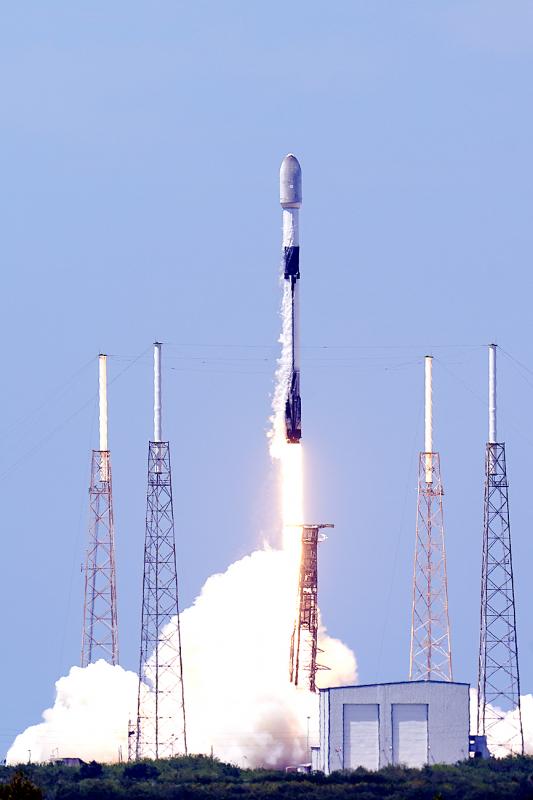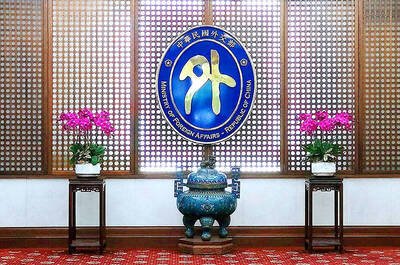Chunghwa Telecom Co yesterday said it is exploring partnerships with low Earth orbit satellite service providers led by Elon Musk’s Starlink project to offer diverse services and enhance its Internet coverage beyond 5G broadband technology.
“There are several non-geostationary orbit satellite systems under development globally, with Starlink taking the lead. Chunghwa Telecom does not rule out seeking exchanges and cooperation with those international operators,” the company said in a statement.
It would comply with the government’s satellite services regulations and evaluate further collaboration opportunities, it said.

Photo: AP
The nation’s biggest telecom said it is paying attention to the development of next-generation technologies for geosynchronous orbit satellites, low Earth orbit satellites, and beyond-5G and 6G connectivity.
Among those, low Earth orbit satellite technology has the potential to help the company diversify its services and supplement terrestrial 5G infrastructure to boost its network coverage, the statement said.
Chunghwa Telecom made the announcement after the Chinese-language Commercial Times yesterday reported that the company is to launch a satellite service with Starlink next year at the earliest.

Photo: CNA
Starlink, a division of US rocket supplier SpaceX, provides Internet access via satellites that are more than 60 times closer to Earth than traditional satellites, resulting in lower latency and the ability to support services typically not possible with traditional satellites, particularly in remote areas.
Starlink has so far signed up 9,000 users in 12 countries, CNBC reported early this month.
Chunghwa Telecom chairman Hsieh Chi-mao (謝繼茂) told the Commercial Times that Starlink and the telecom have begun preparations to launch the service in Taiwan to ensure that satellite communications do not interfere with the transmission of 5G signals.
The telecom must first secure approval from the National Communications Commission (NCC) before it can offer Starlink services to local customers, NCC Vice Chairman and spokesman Wong Po-tsung (翁柏宗) told the Taipei Times.
“We have to check the Ministry of Transportation and Communications’ Radio Frequency Supply Plan (無線電頻譜供應計畫) and Table of Radio Frequency Allocations (頻率分配表),” Wong said.
“Once the ministry has assigned a certain frequency and bandwidth to be used for a low Earth orbit satellite communication, the telecom would have to submit a business plan on how the service is to be offered to local customers,” Wong said.
According to the latest Radio Frequency Supply Plan, which was published early this month, the government is to release the frequencies of 10,700-12,700 megahertz (MHz), 14,000-14,500MHz, 17,700-20,200MHz, 27,500-27,900MHz and 29,500-30,000MHz for low Earth orbit and synchronous satellite communication in the initial stage.
International satellite service providers would be able to form partnerships with local telecoms that hold spectrum at the frequency band of 28 gigahertz.
SpaceX launched a trial for the Starlink service in October last year, offering satellite Internet access at US$99 per month.
Nevada-based Aerkomm Inc last year filed an application with the NCC to offer a low Earth orbit satellite service in Taiwan and was asked to present a more detailed business plan.
In related news, telecoms that qualify for a government subsidy program would soon receive NT$9.92 billion (US$356.67 million) to be spent on 5G infrastructure.
The funding is part of a five-year incentive program announced by the Executive Yuan last year to reward telecoms that accelerate installations of 5G base stations.
Qualifying telecoms would be given a total subsidy of NT$26.6 billion in the next five years for the construction of base stations, according to the program.
Telecoms would be granted subsidies if they build more base stations than they have promised in their business plans. The more they exceeded their goals, the more government funding they would receive, according to the program.
The NCC is to announce next month telecoms that qualify for the funding.

The Ministry of Foreign Affairs (MOFA) yesterday voiced dissatisfaction with the Comprehensive and Progressive Agreement for Trans- Pacific Partnership (CPTPP), whose latest meeting, concluded earlier the same day, appeared not to address the country’s application. In a statement, MOFA said the CPTPP commission had "once again failed to fairly process Taiwan’s application," attributing the inaction to the bloc’s "succumbing to political pressure," without elaborating. Taiwan submitted its CPTPP application under the name "Separate Customs Territory of Taiwan, Penghu, Kinmen and Matsu" on Sept. 22, 2021 -- less than a week after China

ALIGNED THINKING: Taiwan and Japan have a mutual interest in trade, culture and engineering, and can work together for stability, Cho Jung-tai said Taiwan and Japan are two like-minded countries willing to work together to form a “safety barrier” in the Indo-Pacific region, Premier Cho Jung-tai (卓榮泰) yesterday said at the opening ceremony of the 35th Taiwan-Japan Modern Engineering and Technology Symposium in Taipei. Taiwan and Japan are close geographically and closer emotionally, he added. Citing the overflowing of a barrier lake in the Mataian River (馬太鞍溪) in September, Cho said the submersible water level sensors given by Japan during the disaster helped Taiwan monitor the lake’s water levels more accurately. Japan also provided a lot of vaccines early in the outbreak of the COVID-19 pandemic,

Kaohsiung Mayor Chen Chi-mai (陳其邁) on Monday announced light shows and themed traffic lights to welcome fans of South Korean pop group Twice to the port city. The group is to play Kaohsiung on Saturday as part of its “This Is For” world tour. It would be the group’s first performance in Taiwan since its debut 10 years ago. The all-female group consists of five South Koreans, three Japanese and Tainan’s Chou Tzu-yu (周子瑜), the first Taiwan-born and raised member of a South Korean girl group. To promote the group’s arrival, the city has been holding a series of events, including a pop-up

A home-style restaurant opened by a Taiwanese woman in Quezon City in Metro Manila has been featured in the first-ever Michelin Guide honoring exceptional restaurants in the Philippines. The restaurant, Fong Wei Wu (豐味屋), was one of 74 eateries to receive a “Michelin Selected” honor in the guide, while one restaurant received two Michelin stars, eight received one star and 25 were awarded a “Bib Gourmand.” The guide, which was limited to restaurants in Metro Manila and Cebu, was published on Oct. 30. In an interview, Feng Wei Wu’s owner and chef, Linda, said that as a restaurateur in her 60s, receiving an